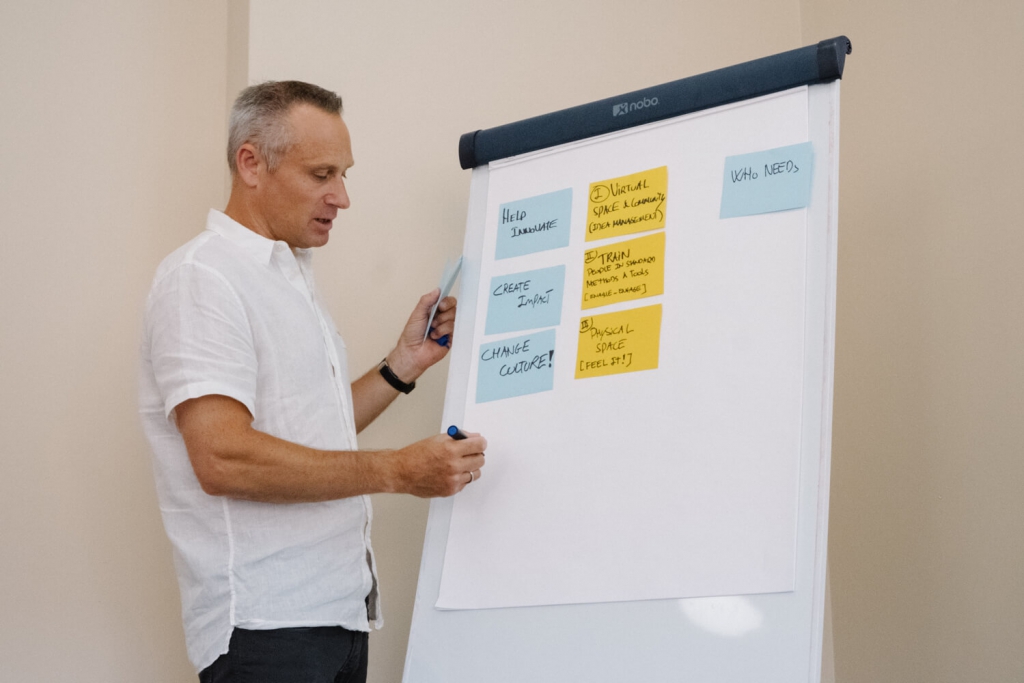
How to validate your ideas, fast
Most innovators will at some point find themselves in the situation of having a full pipeline of ideas, but with little value being created. Incubation processes can help to efficiently validate the potential of the ideas and make well informed and fast decisions with which ones to proceed.
Written by
April 13, 2023
Through our work with clients from across different industries and levels of innovation maturity, we often see how innovation gets stuck between the discovery phase and its further development.This is due to a lack of plan and defined process of what comes after the discovery phase. Without it, there is a great risk of ideas ending in the idea to project vacuum; the space between discovery and development where many great ideas go to die.
In the vacuum between idea and project, no one owns the ideas and no resources have been allocated, and due to their immaturity the ideas cannot be moved on to the existing business yet. Thus, nothing happens. For an idea to create value, someone must own them and dedicate a certain amount of time to further explore and validate them. If there is no process for this, ideation processes can end up being seen as failures or even nuisances for those involved.
Overcoming the idea to project vacuum
Incubation, sometimes also referred to as “validation”, offers a structured and managed process after the ideation phase. Thus, ensuring that ideas won’t get stuck in the “idea to project vacuum”. It involves taking early stage ideas from the first concept to investment decision by testing and validating key-hypothesis on feasibility, market fit and demand as well as business potential. The key principles are small teams, short but frequent feedback and meetings, adoptable plans, and fast decision-making.
In our experience, incubation is unfortunately often overlooked and undervalued. Many companies don’t consider it as part of their innovation process and thus, don’t have an established framework or the necessary resources allocated for it. As a result, a lot of high-potential ideas are wasted by not being developed to their full potential or, in some cases, tie up unnecessary resources despite their lack of e.g., market potential. We see the latter especially in tech-companies. Researchers fall in love with a new technology but fail to investigate the market potential before spending endless resources developing the technology.
It thus goes without saying that having a clear framework for incubation is critical for avoiding aforementioned pitfalls. The advantages are to quickly move promising ideas forward and close those with little to no potential. Although the upfront investment in resources might seem high, it is small compared to losing out on high-potential ideas or investing in the wrong ideas. We have seen examples of both.
How to best structure your incubation process
When it comes to format and structure for incubation, we have seen different examples work equally well.
Incubation Friday
The simplest format is the “Incubation Friday” that Husqvarna has applied successfully. 5 teams get 8 Fridays to work on their ideas, after which a decision is made on which ideas should continue on. The advantage is fast validation with a minimum of resources that do not need to be taken out of current roles. The method is mostly fit for quite advanced ideas, where only a few assumptions need to be validated.
3-months validation
The most applied format is the 3-months validation applied by e.g. KUKA, Raiffaisen Landesbank and many more. This format gives teams of 3-4 people 3 months of leave from their current roles. During the three months, assumptions of both market, technology and business are explored and the result is a data-based pitch with a clear recommendation from the team. The advantage is that the team gets quite far even on ideas with high uncertainty. The method fits most projects, but might not be enough time for complex technology projects.
Entrepreneur in residence
In the entrepreneur in residence format one person is relieved from his/her job and given one year to validate the idea and build a business. The project refers to top-level decision makers and is followed through quarterly reviews. This format is especially fitting for new technology development and completely new business areas.
Common for all formats is the gate meeting at the end of the incubation. It determines the fate of the idea based on a pitch and recommendation from the team behind it. The decision can be to either a) close the project, b) integrate into a suiting business unit or project or set up a new unit or c) continue the project in another loop of incubation. The decision is based on the data created by the team and is typically followed by an assessment of the competences needed going forward; should the team continue as is, or are other competences needed?
Through our work in Nosco, we have seen many successful incubations that have resulted in highly successful new products being developed, as well as projects being closed and resources freed up – these are also success stories worth sharing! We would love to share all results coming out of the incubation projects, but for confidentiality reasons (and for the simple reason that some are still in development) we cannot share them all. Here are a few that we can share:
WallCraft by Evonik – a self-healing concrete that extends the lifetime of concrete constructions. The idea came out of their 2016 innovation challenge and was refined through a 1-year incubation process by Sarah Hintermayer.
Read more about WallCraft
Blue Lithium by Evonik – a new way of extracting and recycling lithium, used in batteries for e.g. electric cars. This idea also came out of an innovation challenge, and it has been developed by Alessandro Dani.
Read more about Blue Lithium
DockIt ® by Covestro – a technology that simplifies and speeds up the dispensing of automotive refinish paints in paint shops. The idea came out of the 2018 innovation challenge and has been refined by Marc Schreiber.
Read more about DockIt
ReSpare by Husqvarna – a marketplace for Husqvarna dealers to sell and buy spare parts. The idea came out of the Shotgun challenge, an ideation event for employees, and was matured in an incubation process consisting of a series of interviews, email tests and beta version of the website.
Check out ReSpare

Thilde is an experienced consultant with a background strategy, business development and innovation within large corporations. She is the “whisper in the ear” of campaign managers and is specialised in communication and mobilisation. Thilde also has a long-term connection to Copenhagen Business School, acting as a lecturer and examiner within innovation and strategy.
MORE ARTICLES






